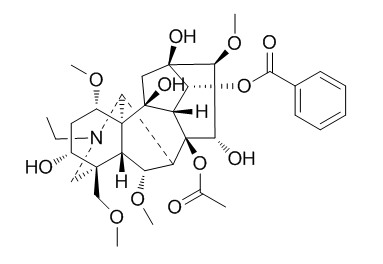Nagarine
Nagarine has toxic and analgesic effects.
Inquire / Order:
manager@chemfaces.com
Technical Inquiries:
service@chemfaces.com
Tel:
+86-27-84237783
Fax:
+86-27-84254680
Address:
1 Building, No. 83, CheCheng Rd., Wuhan Economic and Technological Development Zone, Wuhan, Hubei 430056, PRC
Providing storage is as stated on the product vial and the vial is kept tightly sealed, the product can be stored for up to
24 months(2-8C).
Wherever possible, you should prepare and use solutions on the same day. However, if you need to make up stock solutions in advance, we recommend that you store the solution as aliquots in tightly sealed vials at -20C. Generally, these will be useable for up to two weeks. Before use, and prior to opening the vial we recommend that you allow your product to equilibrate to room temperature for at least 1 hour.
Need more advice on solubility, usage and handling? Please email to: service@chemfaces.com
The packaging of the product may have turned upside down during transportation, resulting in the natural compounds adhering to the neck or cap of the vial. take the vial out of its packaging and gently shake to let the compounds fall to the bottom of the vial. for liquid products, centrifuge at 200-500 RPM to gather the liquid at the bottom of the vial. try to avoid loss or contamination during handling.
Sci Rep. 2024, 14(1):70.
ACS Omega.2022, 7(44):40009-40020.
Toxicol In Vitro.2022, 81:105346.
Antioxidants2022, 11(2),234.
Int J Mol Sci.2021, 22(12):6466.
Applied Biological Chemistry2023, 66(58):112.
J Biol Chem.2021, 297(6):101362.
Cell Prolif.2021, 54(8):e13083.
Korean J of Medicinal Crop Science2018, 220-226
Front Plant Sci.2022, 13:982771.
Related and Featured Products
Fundam Clin Pharmacol. 2004 Dec;18(6):699-704.
A QSAR analysis of toxicity of Aconitum alkaloids.[Pubmed:
15548242]
Biological activity of Aconitum alkaloids may be related to their toxicity rather than to a specific pharmacological action.
METHODS AND RESULTS:
A Quantitative structure-activity relationships (QSAR) analysis was performed on the following two groups of alkaloids: compounds with an aroyl/aroyloxy group at R(14) position (yunaconitine, bulleyaconitine, aconitine, beiwutine, Nagarine, 3-acetyl aconitine, and penduline), and compounds with the aroyloxy group at R(4) position (N-deacetyllappaconitine, lappaconitine, ranaconitine, N-deacetylfinaconitine, N-deacetylranaconitine). The LD(50) (micromol/kg) of the 12 alkaloids were obtained from the literature. LD(50) was significantly lower in group 1 than in group 2. The steric and core-core repulsion energies were significantly higher in group 1. The total energy and heat of formation and electronic energies were significantly lower in group 1. The reactivity index of N, C1', C4' and C6' were similar between groups. The reactivity index of C2' was significantly higher and the reactivity index of C3' and C5' were significantly lower in group 1. Log P and pKa were similar between groups. Molecular weight was significantly higher in group 1. A significant linear relationship was observed between log LD(50) and either analgesic log ED(50) or local anesthetic log ED(50). The LD(50)/analgesic ED(50) obtained from average values was 5.9 for group 1 and 5.0 for group 2. However, the LD(50)/local anesthetic ED(50) was 40.4 and 318, respectively.
CONCLUSIONS:
The study supports that the analgesic effects of these alkaloids are secondary to their toxic effects whereas alkaloids from group 2 are susceptible to be further studied as local anesthetic agents.



